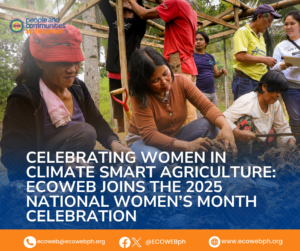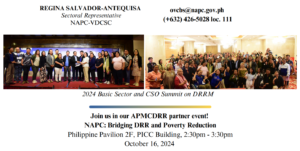(by Rockrock Antequisa, PDA, ECOWEB)
The Manobo indigenous people
The Manobo are one of the the largest ethnolinguistic groups among the Indigenous Peoples (IP) in Mindanao, the second largest island in the Philippines. This tribe inhabits the Agusan River basin within the Agusan del Sur province of the Caraga region. The Agusan River basin encompasses a vast plain and marshland along the Agusan River, the longest river in Mindanao. Traditionally, the Moanobo inhabit villages along the Agusan River, its tributaries, and the marshland. Anthropological studies have revealed that the Manobo people, originally and seafaring, were compelled to move inland and settle in the Agusan Marshland due to the gradual arrival of subsequent tribes that occupied the deltas at the mouth and banks of the Agusan River.
“According to elder accounts, our ancestors resisted conversion to Christianity as Spanish missionaries expanded their influence from the coastal areas towards the interior part of the Agusan river basin,” shared Cedric de Venancio, a Manobo and the Ancestral Domain Development Officer of the IP-Resilience Project of the Ecosystems Work for Essential Benefits, Inc. (ECOWEB). “Jesuit missionaries led our ancestors from the coastline to the tributary rivers of the Agusan Marsh. They also renamed our villages as La Paz and Loreto and baptized our ancestors, assigning them Spanish-sounding family names.”
“Despite the penetration of Christianity, the Manobo managed to preserve their indigenous customs, traditions, and social structure,” noted Charis Nida Boligor, the Capacity Building Officer of ECOWEB IP Resilience Project. “Many individuals, particularly the elders residing in the hinterlands, retain their indigenous knowledge and practices. They possess remarkale skills in predicting weather patterns by observing their environment. They uphold their indigenous political system and continue to respect their Baes and Datus.”
Bae Lolita, Datu Roberto, and Barangay Katipunan
“My ancestors have dwelled in Loreto since ancient times, deriving their sustenance from the lands and waters of the Agusan basin,” explained Lolita Ignacio, 62 years old Bae (female traditional leader) and member of the Indigenous Peoples Structure (IPS) of the ancestral domain, during the Livelihoods Vulnerability and Capacity Assessment (LVCA) workshop facilitated by ECOWEB project team. “This danao (marshland) and its rivers constitute our home and our tribe’s domain. This is owned and nurtured by our ancestors who stewarded this to us for present habitation. We also borrowed it from the future generations.”
 Bae Lolita Ignacio, 62-year old member of the Indigenous Political Structure of CADT-090 during the Livelihoods Vulnerability and Capacity Assessment (LVCA) of barangay Katipunan in the ancestral domain under CADT-090 in the municipality of Loreto, Agusan del Sur in April 2023.
Bae Lolita Ignacio, 62-year old member of the Indigenous Political Structure of CADT-090 during the Livelihoods Vulnerability and Capacity Assessment (LVCA) of barangay Katipunan in the ancestral domain under CADT-090 in the municipality of Loreto, Agusan del Sur in April 2023.
“I was born in Loreto. When I was young, I used to take baths, swim around, and have fun in the Umajam River. I hunted and fished in the danao with my father,” reminisced 64-year old Datu Roberto Ayala, a member of the Indigenous Political Structure (IPS) of CADT-090 also during the LVCA workshop held in Barangay Katipunan. “The danao is our domain. It belongs to the Manobo people.” Datu is a traditional title of men-leaders of the Manobo tribe.
Datu Roberto Ayala, 64-year old, a member of the IPS of CADT-090 explaining the rationale, purpose, and benefits of the Boat Transport Project for barangay Katipunan during the LVCA Validation and Climate Smart Innovations Preparation workshop for barangay Katipunan in April 2023.
The Agusan Marsh and its surroundings shaped the lives of the Manobo people, becoming an integral part of their identity. When the marsh changes, the lives of the Manobo tribe are also altered.
“I grew up in Katipunan,” reminisced Bae Lolita. “We used to have small boats to navigate the marshland. I learned to row as a young girl. The water level was relatively stable back then. Rain wasn’t heavy and flooding was rare. Nowadays, the marshland’s water is unpredictable. To ensure travel during floods, we need a bigger and community-owned more reliable boat for emergencies and transport.”
Barangay Katipunan in the municipality of Loreto, Agusan del Sur is situated along the Umajam River, a major Agusan River tributary. Loreto, a former Spanish Jesuit mission, evolved into a municipality for Christianized and non-Christianized Manobo, and migrants. Katipunan, 3 kilometers from the center of Loreto, is boat accessible via the Umajam River, connecting Manobo villages.
The IP Resilience Project and the local context
ECOWEB in partnership with Help – Hilfe zur Selbsthilfe e.V. and with funding support from the Federal Ministry for Economic Cooperation and Development (BMZ) and Aktion Deutschland Hilft (ADH), is implementing the Indigenous Peoples Resilience Building Project (IPR Project) in the province of Agusan del Sur, Philippines. The project aims to provide support for strengthening socioeconomic resilience and self-determination of indigenous peoples (IPs) in Caraga Region particularly in the two titled ancestral domains in the municipalities of La Paz and Loreto under Certificate of Ancestral Domain Title Nos. 117 and 090 (CADT 117 and CADT 090) respectively. Barangay Katipunan is one of the barangays (villages) within CADT-090. Bae Lolita Ignacio and Datu Roberto Ayala, from CADT-090, are direct beneficiaries who who participated in the LVCA activity, a key initial activity for indigenous leaders.
One IPR Project component enhances disaster risk reduction and climate change adaptation in ancestral domains. In April 2023, an LVCA session was conducted in Katipunan, revealing transportation’s vital role for building community resilience. The community’s vulnerability to changing conditions was evident, prompting the need for transport support.
Torrential and prolonged rains swells rivers, inundating villages. Strong currents render traditional boats unsuitable. The Manobos started using small motorized boats but as the river currents become stronger during rainy seasons, they started to build bigger boats, but high costs limits accessibility for the majority.
Increasing risk and vulnerability
“During the onset of the flood season, many families evacuate to Poblacion and other barangays,” said Datu Roberto. “Most Manobo cannot afford to construct bigger boats. Only very few families in the community have bigger boats mainly for family use.”
“For-hire boats are expensive,” lamented Bae Lolita. “Transporting goods to Poblacion becomes costly hindering access to market. We have fertile soil and can easily grow crops but high cost of transport make farming not economically viable.”
Local capacity and needed support
“I came from a family of boat builders. Boat building is one of the skills handed to us by our ancestors,” explained Datu Roberto. “We have skilled carpenters who can build bigger boats but we cannot afford the high cost of the materials and the engine. But we need to build more resilient boats and we have the knowledge and skills handed to us by our ancestors.”
Participants of the Livelihoods Vulnerabilities and Capacities Assessment in Barangay Katipunan in CADT-090.
“Boat-building stands as an ancient and vital artistry within the heart of the Agusan Marsh Manobos,” emphasized Randy Coguit, a Manobo and member of the IP Resilience Team. “Long before the advent of roads, our ancestors traveled across distant lands propelled by sails upon boats crafted by their own hands. As a young boy I learned the arts of rowing and sailing. We also knew what trees are good for boat-building and we have all of them within our ancestral domain.”
The LVCA results and recommendations were packaged by the Livelihoods and Social Enterprise Team (LSET) of the IP-Resilience Project and the results were presented to the wider community. Bae Lolita and Datu Roberto who participated in the LVCA were the ones tasked to present their proposed Boat Transport Project.
The Boat Transport Project
“We need bigger and sturdier boats and we need support for their construction,” explained Bae Lolita. “We have been asking assistance from government agencies. Some barangays received better boats but we haven’t. Maybe the priority of the government is to construct road not to give boats for transport.”
“Boat transport is the only reliable means of going to and from our community,” Datu Roberto argued during the validation of the LVCA result in Barangay Katipunan. “It is reliable because we can use it during normal days and during the flood season where the water is increasingly becoming deeper and the duration much longer.”
The Boat and ECOWEB Staff.
Chares Nida Boligor (standing) and Teresa Abesamis (sitting) preparing to board the boat provided by the IP Resilience project to the community of Katipunan, Loreto Agusan del Sur in ancestral domain CADT-090. The two staff are on their way returning to Loreto, Poblacion after their community monitoring visit.
The villagers who participated in the validation unanimously voted the Boat Transport Project as their priority project for climate change adaptation and to serve transport needs of community. Datu Roberto was chosen by the community to led the community procurement team and to oversee the construction of the boat.
“The Boat Transport project is very important to the people of Katipunan, the result of the LVCA pointed this out and it was validated by the community representatives during the LVCA validation session. The community representatives came up with a management structure of the project. They also agreed a reasonable amount of charges for fare of people and cargoes,” says Regie Abraham, the Livelihoods and Social Enterprise Facilitator (LSEDF) of the IP Resilience Project of ECOWEB.
Gender concerns in the Boat Transport Project
“The process of planning and decision-making was participatory. Men, women, and young people participated during the LVCA and during the validation,” explained Teresa Abesamis, the community development facilitator of the IP Resilience project assigned in CADT-090. “The Datus and Baes, and some elected barangay officials were also present. Everyone listened to each other during the process of project prioritization.
“Women actively participated in the planning process. It is interesting to note that women stressed the project’s importance for the safety of their families especially the children during emergency situations,” says Rena Davis, LSEDF who focused on gender and inclusion. “Men articulated more on the economic benefits of the Boat Transport project. Both men and women were concern of making sure that the project will be managed and maintained well.”
ECOWEB has a gender and inclusion policy that guides the designing and implementing projects. Participation of men, women, and other genders are encouraged during the planning and implementation. The various gender concerns are discussed during the project planning, implementation and monitoring process. Projects that could facilitate gender equality in terms of access, use, and control are given more importance.
Disaster Risk Reduction and Climate Change Adaptation
“The Boat Transport Project is an important project for the IP’s in CADT-090 because it increased the community capacity to address the impact of flooding,” explained Niel Gozalez, IPR’s DRR-CCA Officer. “It also enhanced their capacity to adapt with the impact of climate change like the increasing volume and duration of downpours that results to stronger currents in the rivers. It also increases the availability of transport service to the whole community during ordinary days. It can also transport goods and supplies to Katipunan during emergencies.”
The motorized boat could accommodate up to 16 persons (excluding the operator) with a cargo of up to 400 kilograms. If there are less cargo it could carry up to 15 persons. It is equipped with life jackets and driven by 12-horsepower engine. It is operated by IP-LORAMSECA, an organization of Manobos designated by the Indigenous Political Structure as the manager of the Project. IP-LORAMSECA is registered as non-profit organization and duly recognized by the National Commission on Indigenous Peoples (NCIP). The boat is registered with the local government unit who regulate inland water transports.
Recent studies revealed that the Agusan River basin particularly the Agusan Marsh is among the areas highly threatened by climate change. (https://www.nationalgeographic.com/environment/article/world-wetlands-are-slipping-away-agusan-marsh-underscores-stakes)
Barangay Katipunan community members, direct and indirect beneficiaries of the Boat Transport Project of the IP Resilience Project implemented by ECOWEB and HELP.
“When we invited ECOWEB to help our ancestral domain, I thought it was only for the updating of our Ancestral Domain Sustainable Development and Protection (ADSDPP),” says 71-year old Datu Kandibuko, the Chieftain of the Manobos in CADT-090 during the turn-over ceremony. “They mentioned of livelihoods but I did not expect that they will also provide as with a transport facility. This is not a very big project but it is very urgent and important. We have been hoping for this project for a long time. I am old already and could not travel often. This project is for the younger generations especially the children. I am very happy that we have this multi-purpose project – it can increase our capacity to respond to emergency and provide transport service to our economic products. Let’s thank ECOWEB and HELP and all partners. Let’s take care of this boat.”


